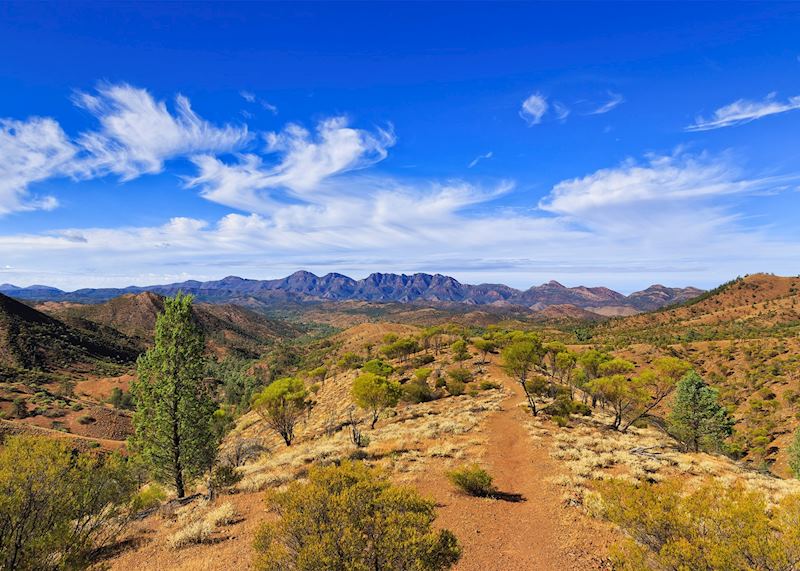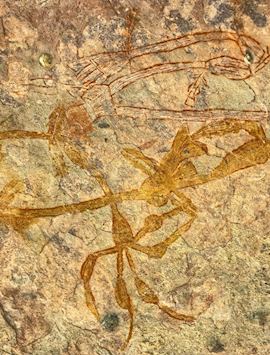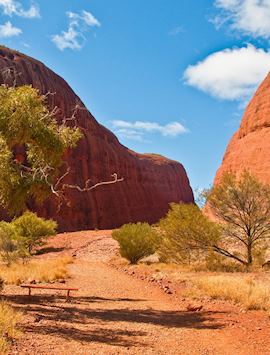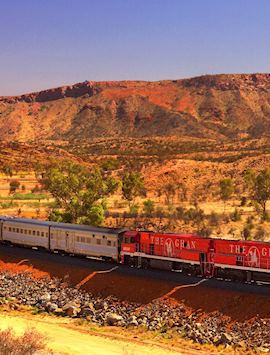Vast plains of blistered orange desert. Forests of perfumed eucalyptus. Rock formations that seem to soar up out of nowhere, piercing the heat-hazed horizon. Coral reefs, alabaster sands, rainforests, and mountains — Australia’s landscapes have got to be of the most compelling reasons to visit this continent-sized country.
But with so much on offer, where exactly should you go? We’ve collated the ten best nature experiences worth shaping your trip around, and suggest ways for how to see these beguiling places at their best.
1. Uluru-Kata Tjuta National Park
Uluru stands tall amid the fiery terrain of the Northern Territory’s endless-seeming outback in the eponymous Uluru-Kata Tjuta National Park. From afar, the tectonically carved mesa appears stark, but walk around its base, and you’ll weave among silver-green mulga trees, arches of mottled sandstone, and even a gum-shaded waterhole. Perhaps the very best time to see it is at sunrise: the stoneface emerges out of the dark, gradually sharpening into tessellations of grey and amber, impossible to see by photograph.
A 40-minute drive from Uluru takes you to the park’s other celebrated landmark, Kata Tjuta. Its 36 domes were formed over 600 million years ago by the waves of a vanished ocean and today, they form undulating megaliths of basalt and granite. You can amble beside them on stony paths of varying lengths, including the aptly named Valley of the Winds.
The park also hums with wildlife. On walking trails, you might spot red kangaroos grazing on grasslands or hear the rippling trill of the Zebra finch as it flits among bloodwood trees.
For your best chance to see wildlife, though, stick around for sunset. As the sky fades into pastel shades and Uluru’s rockface becomes a deep maroon, the Red Centre’s marsupials awaken. Stay overnight in a safari-style tent or enjoy a sunset dinner, and you might spot mice-like mulgaras as they hunt and play.
Get me there: Hike around Uluru and learn about its significance to the Indigenous Anangu people on a trip around Aboriginal Australia.

2. Great Barrier Reef
Hedges of dazzling sea anemones, meadows of clustered coral, and gardens of sleek seagrasses — this is the seascape that makes up the Great Barrier Reef.
Stretching 2,300 km (1,430 miles) along Queensland’s coast, the reef — the largest of its kind — is home to over 9,000 known species. Heading out by boat, you can snorkel or dive beside some of the reef’s more sociable creatures, spotting placid sea turtles or skittering clown fish in between coral thickets.
You don't even have to be in the water to take in the reef's beauty: on a helicopter tour the reef sprawls out before you like a canvas of impasto paint strokes, a swirl of greens, blues, and creams.
Prefer remaining on terra firma? Consider an island stay. Lady Elliot Island, for example, is encircled by beds of staghorn, brain, and boulder corals, which you can swim to straight from the beach. The surrounding waters are packed with manta ray squadrons.
If you’re on a tight schedule, the Whitsunday Islands provide an alternative reef experience closer to the mainland. Situated at the southern end of the Great Barrier Reef Marine Park, the islands make for a balmy refuge where you can intersperse snorkeling or diving trips with fine dining and spa treatments at your pick of first-class resorts.
Get me there: You can snorkel on the Great Barrier Reef on a trip that takes in some of Australia’s headline landscapes.

3. Kakadu National Park
Just three hours’ drive from the city of Darwin, Kakadu National Park is a Switzerland-sized microcosm of Australia’s ecological diversity. Within its borders, you can hike escarpments of quartzite and sandstone, kayak down rivers fed by waterfalls, or take in panoramic views of wetlands where elusive salties (saltwater crocodiles) lurk.
A highlight of the park is Yellow Water, a landlocked billabong named for the algal bloom that gives it its distinctive mustard hue. Visit during the wet season (November to March) to cruise the waterhole surrounded by the earthy scents and waters of accumulated flood plains. From the vessel, you’ll pass lush, deciduous forests from which egrets and jabirus emerge to forage, and skim by rocky billabong banks, where you might spy a saltie basking in the sunshine.
For views of Kakadu from above, take a helicopter ride around the park's waterfalls. Plunging from heights of up to 200 m (660 ft) in the wet season, Jim Jim Falls and Twin Falls are two powerful cascades that leap off towering red-faced precipices. Hike through the surrounding forests of paperbark trees for a chance to spot wombats, wallabies, and wallaroos (a kangaroo-like animal with a shorter, stockier build).
Kakadu has plenty of safari experiences on offer if you’re eager to view more wildlife. You could find yourself swimming alongside freshwater turtles in the emerald plunge pools of Maguk. Or, hike the Mamukala Wetlands, listening out for the baritone honks of the hundreds of magpie geese that make it their home every winter.
Get me there: Consider adding on some time in Kakadu to this journey through remote Western Australia and the Northern Territory.

4. Daintree Rainforest
On the northeast coast of Queensland sit the dense, primeval canopies of the Daintree, a 135-million-year-old rainforest, believed to be the oldest in the world. Rock-hugging waterfalls and thick, tangled jungles of feathery ferns make up another wildlife-rich region — inhabitants include cassowaries and tree kangaroos.
Running through the rainforest and surrounded by contorted, skeletal mangroves is the Daintree River. On a guided boat trip here, you might see salties big and small resting on mossy outcrops or bathing in the river’s tea-toned waters.
We suggest heading south to Mossman Gorge, where you can float in the crystal-clear waters of the Mossman River and follow paths dotted with huge, spiderlike cycads and giant fan palms.
By car, you can reach the Daintree from Cairns or Port Douglas along a scenic coastal road overlooking the Coral Sea. But, time permitting, we recommend staying in the rainforest itself. At Silky Oaks Lodge, you’ll sleep in luxe riverside villas or treehouses built between giant, blue quandong trees and wake up to the whooping calls of the bush turkey.
Get me there: For a chance to spot cassowaries beneath the Daintree’s canopies, consider a leisurely sojourn up Australia’s east coast.

5. Cradle Mountain-Lake St Clair National Park
In the Central Highlands of Tasmania, about a two-and-a-half-hour journey north from Hobart, you’ll come to Cradle Mountain-Lake St Clair National Park. Here eucalyptus forests punctuate the mountainsides and glacial lakes pocket wildflower-strewn heathlands.
If you only have time to visit one place in the park, we recommend hiking its crown jewel — and namesake — Cradle Mountain. Starting among eucalypts, where minty aromas of tea tree hang in the air, you’ll pass through subalpine vegetation to reach the moss-covered peaks.
We’re also fans of a gentler hike around Dove Lake, a deep blue body of water at the northern end of the park. On sunny days, Cradle Mountain is reflected with mirror-like precision on its surface. Then there’s Australia’s deepest lake, Lake St Clair, where you can kayak amid curtains of rainforest and deep canyons. This region is particularly rife with wildlife: keep an eye out for wombats burrowing in the shrubbery.
Get me there: Visit Cradle Mountain on a classic tour of Tasmania.

6. The Kimberley
Roughly the size of California and three times the size of England, the Kimberley, in northwestern Western Australia is as gargantuan as it is wide-ranging, a remote land of aquamarine archipelagos, oxblood canyons, and pearlescent waterfalls.
If you’re driving, we recommend stopping at Purnululu (previously known as Bungle Bungle National Park). The park’s focal point is a range of cupola-shaped mounds of red and black sandstone, which you can take in fully by helicopter.
Another way to experience the Kimberley — and to reach its most isolated parts — is by boat. Only then can you observe natural spectacles like Montgomery Reef. The planet’s largest inshore reef, it appears from beneath the waves like some hulking great ghost ship thanks to the quirks of local tides rising and falling by up to 8 m (26 ft) twice a day.
Venture elsewhere in the region and you could find yourself traipsing mud flats full of feral horses or encountering Indigenous rock art with a Nyikina guide.
Get me there: Cruise through the Kimberley, taking in the highlights of its splintered coastline.

7. The Blue Mountains
Sandstone ridges and waterfalls make up the Blue Mountains, a national park that’s conveniently only an hour’s drive from Sydney. The park’s best known for the Three Sisters, a trio of pillars that stand against a backdrop of gum tree forests. For the finest view of them, visit Echo Point, the highest overlook in the park. There are also walking trails, a funicular, a glass cableway, and a gondola from which you can take in the many angles of the mountains.
You can reach most of the Blue Mountains by car or walking trail from the small town of Katoomba. If you’re staying for a few days, it’s worth hiking to Wentworth Falls — a triple-tiered waterfall that cascades into a peaceful creek. By night, try visiting one of the area’s caves, where you can search for glow worms in pitch-black overhangs.
Get me there: Explore the Blue Mountains on a sustainable trip that takes you from Adelaide to the Great Barrier Reef.

8. Ikara-Flinders Ranges National Park
For an outback experience in South Australia, consider Ikara-Flinders Ranges National Park. Here, cliffs of quartzite, rings of spinifex, and rambling plains create a Martian landscape that’s best experienced through hikes or 4x4 tours. Look out for docile bearded dragons bobbing across the sands and emus loitering near waterholes.
Ikara, also known as Wilpena Pound, is the park’s calling card. This natural amphitheater is the remaining valley floor and outer edges of a 540-million-year-old mountain range, and what endures is a striated coliseum of tawny reds and caramel yellows. The structure is of cultural significance to the Adnyamathanha people, and you can explore with an Adnyamathanha guide to delve into the meanings of the site’s rock art.
Get me there: Combine wine tasting and wildlife spotting at Ikara-Flinders Ranges National Park on a self-drive adventure around South Australia.

9. Ningaloo Reef
The Ningaloo Reef is a hub of aquatic activity thanks to its nutrient-rich waters and location along the warm East Indian Ocean. You could glimpse moray eels darting out of caves of cabbage coral, witness hundreds of tiny cleaner-fish nibbling a tiger shark, or swim with dugongs (a cousin of the manatee). The coral itself resembles a bag of assorted candies, a plethora of gleaming lumps and bumps.
Snorkeling with whale sharks, which is a bit like swimming alongside a London bus, is the reef’s main, but you’ll still see a lot of underwater life by simply drift-snorkeling from the area’s beaches. You can try both of these experiences by staying at Sal Salis, a luxe wilderness camp on the dune fields of Cape Range National Park.
Get me there: Dive with whale sharks, spot quokkas and snorkel with sturgeonfish on a wildlife journey around Western Australia.

10. The Twelve Apostles & Shipwreck Coast
If you’re journeying from Melbourne to Adelaide — and you have time — the best way to get there is via the Great Ocean Road, part of the longer Shipwreck Coast route. The hallmark of the drive is the Twelve Apostles, a series of spire-shaped limestone formations along a sapphire-blue shore. Despite the name, there are only seven Apostles remaining, but the drama of their location — standing defiantly alone between a cliffside and a wave-battered tide — is worth seeing.
You can reach viewpoints over the Twelve Apostles by car, or take a four-day hike along the coast from the resort town of Apollo Bay. Along the way, you’ll be able to spot the Blowhole, a teardrop-shaped tunnel and Loch Ard Gorge, a calmer spot of bay where you can swim.
A trip along the Shipwreck Coast can take anywhere between a couple of hours and several days. For a night’s rest, you can stop at Apollo Bay or visit the Celtic-influenced town of Port Fairy on route.
Get me there: See the highlights of the Shipwreck Coast as you drive from Adelaide to Sydney on a trip around Australia’s southeast coast.

Start planning your trip to Australia
Start thinking about your experience. These itineraries are simply suggestions for how you could enjoy some of the same experiences as our specialists. They're just for inspiration, because your trip will be created around your particular tastes.
View All Tours in Australia



